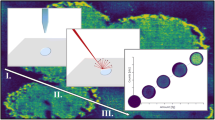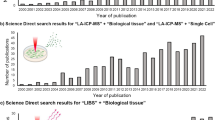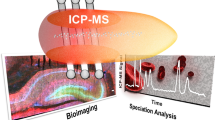Abstract
Laser ablation-inductively coupled plasma-mass spectrometry (LA-ICP-MS) analysis of μ-droplets is becoming an attractive alternative for detecting and quantifying elements in biological samples. With minimal sample preparation required and detection limits comparable to solution nebulisation ICP-MS, μ-droplets have substantial advantages over traditional elemental detection, particularly for low volumes, such as aliquots taken from samples required for multiple independent biochemical assays, or fluids and tissues where elements of interest exist at native concentrations not suited to the necessary dilution steps required for solution nebulisation ICP-MS. However, the characteristics of μ-droplet residue deposition are heavily dependent on the matrix, and potential effects on signal suppression or enhancement have not been fully characterised. We present a validated and flexible high-throughput method for quantification of elements in μ-droplets using LA-ICP-MS imaging and matrix-matched external calibrants. Imaging the entire μ-droplet area removes analytical uncertainty arising from the often-heterogenous distribution when compared to radial or bisecting line scans that capture only a small portion of the droplet residue. We examined the effects of common matrices found in a standard biochemistry workflow, including native protein and salt contents, as well as reagents used in typical preparation steps for concurrent biochemical assays, such as total protein quantification and enzyme activity assays. We found that matrix composition results in systemic, concentration-dependent signal enhancement and suppression for carbon, whereas high sodium content has a specific space-charge-like suppression effect on high masses. We confirmed the accuracy of our method using both a certified serum standard (Seronorm™ L1) and independent measurements of analysed samples by solution nebulisation ICP-MS, then tested the specificity and reproducibility by examining spinal cord tissue homogenates from SOD1-G93A transgenic mice with a known molecular phenotype of increased copper- and zinc-binding superoxide dismutase-1 expression and altered copper-to-zinc stoichiometry. The method presented is rapid and transferable to multiple other biological matrices and allows high-throughput analysis of low-volume samples with sensitivity comparable to standard solution nebulisation ICP-MS protocols.

ᅟ





Similar content being viewed by others
References
Kinoshita K, Nakamura H. Identification of the ligand binding sites on the molecular surface of proteins. Protein Sci. 2005;14:711–8. https://doi.org/10.1110/ps.041080105.
del Sol A, del Mesa A, Pazos F, Valencia A. Automatic methods for predicting functionally important residues. J Mol Biol. 2003;326:1289–302. https://doi.org/10.1016/S0022-2836(02)01451-1.
Waldron KJ, Rutherford JC, Ford D, Robinson NJ. Metalloproteins and metal sensing. Nature. 2009;460:823–30. https://doi.org/10.1038/nature08300.
Andreini C, Bertini I, Cavallaro G, Holliday GL, Thornton JM. Metal ions in biological catalysis: from enzyme databases to general principles. JBIC J Biol Inorg Chem. 2008;13:1205–18. https://doi.org/10.1007/s00775-008-0404-5.
Barnham KJ, Bush AI. Biological metals and metal-targeting compounds in major neurodegenerative diseases. Chem Soc Rev. 2014;43:6727–49. https://doi.org/10.1039/C4CS00138A.
Fouani L, Menezes SV, Paulson M, Richardson DR, Kovacevic Z. Metals and metastasis: exploiting the role of metals in cancer metastasis to develop novel anti-metastatic agents. Pharmacol Res. 2017;115:275–87. https://doi.org/10.1016/j.phrs.2016.12.001.
Michalke B. Platinum speciation used for elucidating activation or inhibition of Pt-containing anti-cancer drugs. J Trace Elem Med Biol. 2010;24:69–77. https://doi.org/10.1016/j.jtemb.2010.01.006.
Geraldes CFGC, Laurent S. Classification and basic properties of contrast agents for magnetic resonance imaging. Contrast Media Mol Imaging. 2009;4:1–23. https://doi.org/10.1002/cmmi.265.
Zhu G, Browner FR. Investigation of experimental parameters with a quadrupole ICP/MS. Appl Spectrosc. 1987;41
Lear J, Hare DJ, Fryer F, Adlard PA, Finkelstein DI, Doble PA. High-resolution elemental bioimaging of Ca, Mn, Fe, Co, Cu, and Zn employing LA-ICP-MS and hydrogen reaction gas. Anal Chem. 2012;84:6707–14. https://doi.org/10.1021/ac301156f.
Dyer PE, Karnakis DM, Key PH, Monk P. Excimer laser ablation for micro-machining: geometric effects. In: Fogarassy E, Geohegan D, Stuke M, editors. Laser ablation. Elsevier; 1996.
Hare DJ, Fryer F, Paul B, Bishop DP, Doble PA. Characterisation of matrix-based polyatomic interference formation in laser ablation-inductively coupled plasma-mass spectrometry using dried micro-droplet ablation and its relevance for bioimaging. Anal Methods. 2016;8:7552–6. https://doi.org/10.1039/C6AY02545E.
Yang L, Sturgeon RE, Mester Z. Quantitation of trace metals in liquid samples by dried-droplet laser ablation inductively coupled plasma mass spectrometry. Anal Chem. 2005;77:2971–7. https://doi.org/10.1021/ac048275a.
Hsieh HF, Chang WS, Hsieh YK, Wang CF. Using dried-droplet laser ablation inductively coupled plasma mass spectrometry to quantify multiple elements in whole blood. Anal Chim Acta. 2011;699:6–10. https://doi.org/10.1016/j.aca.2011.05.002.
Hsieh HF, Chang WS, Hsieh YK, Wang CF. Lead determination in whole blood by laser ablation coupled with inductively coupled plasma mass spectrometry. Talanta. 2009;79:183–8. https://doi.org/10.1016/j.talanta.2009.03.027.
Nischkauer W, Vanhaecke F, Limbeck A. Self-aliquoting micro-grooves in combination with laser ablation-ICP-mass spectrometry for the analysis of challenging liquids: quantification of lead in whole blood. Anal Bioanal Chem. 2016;408:5671–6. https://doi.org/10.1007/s00216-016-9717-3.
Cizdziel JV. Determination of lead in blood by laser ablation ICP-TOF-MS analysis of blood spotted and dried on filter paper: a feasibility study. Anal Bioanal Chem. 2007;388:603–11. https://doi.org/10.1007/s00216-007-1242-y.
Foltynova P, Kanicky V, Preisler J. Diode laser thermal vaporization inductively coupled plasma mass spectrometry. Anal Chem. 2012;84:2268–74. https://doi.org/10.1021/ac202884m.
Aramendia M, Rello L, Berail S, Donard A, Pecheyran C, Resano M. Direct analysis of dried blood spots by femtosecond-laser ablation-inductively coupled plasma-mass spectrometry. Feasibility of split-flow laser ablation for simultaneous trace element and isotopic analysis (vol 30, pg 296, 2015). J Anal At Spectrom. 2015;30:525. https://doi.org/10.1039/c4ja90069c.
Chantada-Vazquez MP, de Becerra-Sanchez C, Fernandez-del-Rio A, Sanchez-Gonzalez J, Bermejo AM, Bermejo-Barrera P, et al. Development and application of molecularly imprinted polymer - Mn-doped ZnS quantum dot fluorescent optosensing for cocaine screening in oral fluid and serum. Talanta. 2018;181:232–8. https://doi.org/10.1016/j.talanta.2018.01.017.
Kumtabtim U, Siripinyanond A, Auray-Blais C, Ntwari A, Becker JS. Analysis of trace metals in single droplet of urine by laser ablation inductively coupled plasma mass spectrometry. Int J Mass Spectrom. 2011;307:174–81. https://doi.org/10.1016/j.ijms.2011.01.030.
Chantada-Vázquez M, Moreda-Piñeiro J, Cantarero-Roldán A, Bermejo-Barrera P, Moreda-Piñeiro A. Development of dried serum spot sampling techniques for the assessment of trace elements in serum samples by LA-ICP-MS. Talanta. 2018;186:169–175. doi:https://doi.org/10.1016/j.talanta.2018.04.049.
Hare D, Austin C, Doble P. Quantification strategies for elemental imaging of biological samples using laser ablation-inductively coupled plasma-mass spectrometry. Analyst. 2012;137:1527–37. https://doi.org/10.1039/c2an15792f.
Pugh JAT, Cox AG, McLeod CW, Bunch J, Whitby B, Gordon B, et al. A novel calibration strategy for analysis and imaging of biological thin sections by laser ablation inductively coupled plasma mass spectrometry. J Anal At Spectrom. 2011;26:1667–73. https://doi.org/10.1039/C1JA10118H.
Moraleja I, Mena ML, Lázaro A, Neumann B, Tejedor A, Jakubowski N, et al. An approach for quantification of platinum distribution in tissues by LA-ICP-MS imaging using isotope dilution analysis. Talanta. 2018;178:166–71. https://doi.org/10.1016/j.talanta.2017.09.031.
Pozebon D, Scheffler GL, Dressler VL. Recent applications of laser ablation inductively coupled plasma mass spectrometry (LA-ICP-MS) for biological sample analysis: a follow-up review. J Anal At Spectrom. 2017;32:890–919. https://doi.org/10.1039/c7ja00026j.
Pozebon D, Scheffler GL, Dressler VL, Nunes MAG. Review of the applications of laser ablation inductively coupled plasma mass spectrometry (LA-ICP-MS) to the analysis of biological samples. J Anal At Spectrom. 2014;29:2204–28. https://doi.org/10.1039/c4ja00250d.
Paul B, Hare DJ, Bishop DP, Paton C, Nguyen VT, Cole N, et al. Visualising mouse neuroanatomy and function by metal distribution using laser ablation-inductively coupled plasma-mass spectrometry imaging (vol 6, pg 5383, 2015). Chem Sci. 2016;7:6576. https://doi.org/10.1039/c6sc90060g.
Paul B, Paton C, Norris A, Woodhead J, Hellstrom J, Hergt J, et al. CellSpace: a module for creating spatially registered laser ablation images within the Iolite freeware environment. J Anal At Spectrom. 2012;27:700–6. https://doi.org/10.1039/c2ja10383d.
Sforna MC, Lugli F. MapIT!: a simple and user-friendly MATLAB script to elaborate elemental distribution images from LA-ICP-MS data. J Anal At Spectrom. 2017;32:1035–43. https://doi.org/10.1039/c7ja00023e.
López-Fernández H, de Pessôa GS, Arruda MAZ, Capelo-Martínez JL, Fdez-Riverola F, Glez-Peña D, et al. LA-iMageS: a software for elemental distribution bioimaging using LA–ICP–MS data. J Cheminform. 2016;8:65. https://doi.org/10.1186/s13321-016-0178-7.
Nischkauer W, Vanhaecke F, Bernacchi S, Herwig C, Limbeck A. Radial line-scans as representative sampling strategy in dried-droplet laser ablation of liquid samples deposited on pre-cut filter paper disks. Spectrochim Acta Part B At Spectrosc. 2014;101:123–9. https://doi.org/10.1016/j.sab.2014.07.023.
Hilton JB, Mercer SW, Lim NK, Faux NG, Buncic G, Beckman JS, et al. Cu(II)(atsm) improves the neurological phenotype and survival of SOD1(G93A) mice and selectively increases enzymatically active SOD1 in the spinal cord. Sci Rep. 2017;7:42292. https://doi.org/10.1038/srep42292.
Grehn M, Seuthe T, Höfner M, Griga N, Theiss C, Mermillod-Blondin A, et al. Femtosecond-laser induced ablation of silicate glasses and the intrinsic dissociation energy. Opt Mater Express. 2014;4:689–700. https://doi.org/10.1364/ome.4.000689.
Bishop DP, Clases D, Fryer F, Williams E, Wilkins S, Hare DJ, et al. Elemental bio-imaging using laser ablation-triple quadrupole-ICP-MS. J Anal At Spectrom. 2016;31:197–202. https://doi.org/10.1039/c5ja00293a.
Lear J, Hare D, Adlard P, Finkelstein D, Doble P. Improving acquisition times of elemental bio-imaging for quadrupole-based LA-ICP-MS. J Anal At Spectrom. 2012;27:159–64. https://doi.org/10.1039/C1JA10301F.
Paton C, Hellstrom J, Paul B, Woodhead J, Hergt J. Iolite: freeware for the visualisation and processing of mass spectrometric data. J Anal At Spectrom. 2011;26:2508–18. https://doi.org/10.1039/C1JA10172B.
Hare DJ, Kysenius K, Paul B, Knauer B, Hutchinson RW, O’Connor C, et al. Imaging metals in brain tissue by laser ablation - inductively coupled plasma - mass spectrometry (LA-ICP-MS). J Vis Exp. 2017; https://doi.org/10.3791/55042.
Topalä T, Bodoki A, Oprean L, Oprean R. Bovine serum albumin interactions with metal complexes. Clujul Med. 2014;87:215–9. https://doi.org/10.15386/cjmed-357.
Michalke B, Nischwitz V. Review on metal speciation analysis in cerebrospinal fluid—current methods and results: a review. Anal Chim Acta. 2010;682:23–36. https://doi.org/10.1016/j.aca.2010.09.054.
Nischwitz V, Berthele A, Michalke B. Speciation analysis of selected metals and determination of their total contents in paired serum and cerebrospinal fluid samples: an approach to investigate the permeability of the human blood-cerebrospinal fluid-barrier. Anal Chim Acta. 2008;627:258–69. https://doi.org/10.1016/j.aca.2008.08.018.
Roberts BR, Doecke JD, Rembach A, Yévenes FL, Fowler CJ, McLean CA, et al. Rubidium and potassium levels are altered in Alzheimer’s disease brain and blood but not in cerebrospinal fluid. Acta Neuropathol Commun. 2016;4:119. https://doi.org/10.1186/s40478-016-0390-8.
Hare DJ, Lear J, Bishop D, Beavis A, Doble PA. Protocol for production of matrix-matched brain tissue standards for imaging by laser ablation-inductively coupled plasma- mass spectrometry. Anal Methods. 2013;5:1915–21. https://doi.org/10.1039/C3AY26248K.
Christensen R. Log-linear models and logistic regression. 2nd ed. Springer-Verlag; 2006.
Saadati N, Abdullah M, Zakaria Z, Sany S, Rezayi M, Hassonizadeh H. Limit of detection and limit of quantification development procedures for organochlorine pesticides analysis in water and sediment matrices. Chem Cent J. 2013;7:1–10. https://doi.org/10.1186/1752-153X-7-63.
May TW, Wiedmeyer RH. A table of polyatomic interferences in ICP-MS. At Spectrosc. 1998;19:150–5.
Allain P, Jaunault L, Mauras Y, Mermet J, Delaporte T. Signal enhancement of elements due to the presence of carbon-containing compounds in inductively coupled plasma mass spectrometry. Anal Chem. 1991;63:1497–8. https://doi.org/10.1021/ac00014a028.
Wiltsche H, Winkler M, Tirk P. Matrix effects of carbon and bromine in inductively coupled plasma optical emission spectrometry. J Anal At Spectrom. 2015;30:2223–34. https://doi.org/10.1039/C5JA00237K.
Tanner SD. Space charge in ICP-MS: calculation and implications. Spectrochim Acta Part B At Spectrosc. 1992;47:809–23. https://doi.org/10.1016/0584-8547(92)80076-S.
Vanhaecke F, Dams R, Vandecasteele C. ‘Zone model’ as an explanation for signal behaviour and non-spectral interferences in inductively coupled plasma mass spectrometry. J Anal At Spectrom. 1993;8:433–8. https://doi.org/10.1039/JA9930800433.
Frick DA, Günther D. Fundamental studies on the ablation behaviour of carbon in LA-ICP-MS with respect to the suitability as internal standard. J Anal At Spectrom. 2012;27:1294–303. https://doi.org/10.1039/C2JA30072A.
Limbeck A, Galler P, Bonta M, Bauer G, Nischkauer W, Vanhaecke F. Recent advances in quantitative LA-ICP-MS analysis: challenges and solutions in the life sciences and environmental chemistry. Anal Bioanal Chem. 2015;407:6593–617. https://doi.org/10.1007/s00216-015-8858-0.
Austin C, Fryer F, Lear J, Bishop D, Hare D, Rawling T, et al. Factors affecting internal standard selection for quantitative elemental bio-imaging of soft tissues by LA-ICP-MS. J Anal At Spectrom. 2011;26:1494–501. https://doi.org/10.1039/C0JA00267D.
ISO 5725-1: Accuracy (trueness and precision) of measurement methods and results — Part 1: General principles and definitions. Geneva 1994.
Roudeau S, Chevreux S, Carmona A, Ortega R. Reduced net charge and heterogeneity of pI isoforms in familial amyotrophic lateral sclerosis mutants of copper/zinc superoxide dismutase. Electrophoresis. 2015;36:2482–8. https://doi.org/10.1002/elps.201500187.
Gurney ME. The use of transgenic mouse models of amyotrophic lateral sclerosis in preclinical drug studies. J Neurol Sci. 1997;152 https://doi.org/10.1016/S0022-510X(97)00247-5.
Hilton JB, White AR, Crouch PJ. Endogenous Cu in the central nervous system fails to satiate the elevated requirement for Cu in a mutant SOD1 mouse model of ALS. Metallomics. 2016;8:1002–11. https://doi.org/10.1039/c6mt00099a.
Roberts BR, Lim NK, McAllum EJ, Donnelly PS, Hare DJ, Doble PA, et al. Oral treatment with CuII(atsm) increases mutant SOD1 in vivo but protects motor neurons and improves the phenotype of a transgenic mouse model of amyotrophic lateral sclerosis. J Neurosci. 2014;34:8021–31. https://doi.org/10.1523/JNEUROSCI.4196-13.2014.
Heffernan AL, Hare DJ. Tracing environmental exposure from neurodevelopment to neurodegeneration. Trends Neurosci. 2018;41:496–501. https://doi.org/10.1016/j.tins.2018.04.005.
McIntyre PG. How many drops of CSF is enough? Postgrad Med J. 2007;83:158.
Maass F, Michalke B, Leha A, Boerger M, Zerr I, Koch JC, et al. Elemental fingerprint as a cerebrospinal fluid biomarker for the diagnosis of Parkinson’s disease. J Neurochem. 2018;145:342–51. https://doi.org/10.1111/jnc.14316.
Cardoso B, Hare DJ, Bush A, Li Q-X, Fowler C, Masters C et al. Selenium levels in serum, red blood cells, and cerebrospinal fluid of Alzheimer’s disease patients: a report from the Australian Imaging, Biomarker & Lifestyle Flagship Study of Ageing (AIBL). J Alzheimers Dis. 2017;Preprint. doi:https://doi.org/10.3233/JAD-160622.
Gerhardsson L, Lundh T, Minthon L, Londos E. Metal concentrations in plasma and cerebrospinal fluid in patients with Alzheimer’s disease. Dement Geriatr Cogn Disord. 2008;25:508–15. https://doi.org/10.1159/000129365.
Barany E, Bergdahl IA, SchÜTz A, Skerfving S, Oskarsson A. Inductively coupled plasma mass spectrometry for direct multi-element analysis of diluted human blood and serum. J Anal At Spectrom. 1997;12:1005–9. https://doi.org/10.1039/A700904F.
Theiner S, Malderen SJM, Acker T, Legin AA, Keppler BK, Vanhaecke F, et al. Fast high-resolution LA-ICP-MS imaging of the distribution of platinum-based anti-cancer compounds in multicellular tumor spheroids. Anal Chem. 2017;89:12641–5. https://doi.org/10.1021/acs.analchem.7b02681.
Malderen SJM, Laforce B, Acker T, Nys C, Rijcke M, de Rycke R, et al. Three-dimensional reconstruction of the tissue-specific multielemental distribution within Ceriodaphnia dubia via multimodal registration using laser ablation ICP-mass spectrometry and X-ray spectroscopic techniques. Anal Chem. 2017;89:4161–8. https://doi.org/10.1021/acs.analchem.7b00111.
Fittschen UE, Bings NH, Hauschild S, Forster S, Kiera AF, Karavani E, et al. Characteristics of picoliter droplet dried residues as standards for direct analysis techniques. Anal Chem. 2008;80:1967–77. https://doi.org/10.1021/ac702005x.
Fittschen UE, Havrilla GJ. Picoliter droplet deposition using a prototype picoliter pipette: control parameters and application in micro X-ray fluorescence. Anal Chem. 2010;82:297–306. https://doi.org/10.1021/ac901979p.
Acknowledgements
KK was a recipient of the Sigrid Juselius Foundation Postdoctoral Fellowship (Finland). DJH is a NHMRC Career Development Fellow (CDF1) - Industry (1122981) with Agilent Technologies. PJC is an NHMRC Career Development Fellow (CDF2 - 1084927). We wish to the Prize4Life Organization for providing experimental transgenic mice. The Florey Institute of Neuroscience and Mental Health acknowledge the strong support from the Victorian Government and the funding from the Operational Infrastructure Support Grant.
Funding
This study received support from the Jenny Barr Smith, Betty Laidlaw, and Jenny Simko Research Grants from the MND Research Institute of Australia.
Author information
Authors and Affiliations
Contributions
Peter J Crouch and Kai Kysenius designed the project, prepared the samples, and edited the manuscript. Kai Kysenius performed the analyses, prepared the figures, and wrote the manuscript. James B Hilton and Jeffrey R Liddell prepared the samples and edited the manuscript. Dominic J Hare performed the SN-ICP-MS analysis and edited the manuscript. Bence Paul wrote the Iolite analysis code and edited the manuscript.
Corresponding author
Ethics declarations
The use of biological material taken from wild-type C57/B6 and transgenic mice was approved by The University of Melbourne Animal Ethics Committee (approval number 1312908). All procedures were conducted in accordance with National Health and Medical Research Council guidelines.
Conflict of interest statements
Bence Paul receives part of his salary from the sales of the Iolite software. Dominic J Hare receives research and material support from Agilent Technologies through the National Health and Medical Research Career Development Fellowship program. Procypra Therapeutics LLC, Collaborative Medicinal Development LLC, and The University of Melbourne are engaged in development of new therapeutics for ALS using the transgenic animal described herein. The other authors declare that they have no conflict of interest.
Additional information
Published in the topical collection Elemental and Molecular Imaging by LA-ICP-MS with guest editor Beatriz Fernández García.
Electronic supplementary material
ESM 1
(PDF 3.07 mb)
Rights and permissions
About this article
Cite this article
Kysenius, K., Paul, B., Hilton, J.B. et al. A versatile quantitative microdroplet elemental imaging method optimised for integration in biochemical workflows for low-volume samples. Anal Bioanal Chem 411, 603–616 (2019). https://doi.org/10.1007/s00216-018-1362-6
Received:
Revised:
Accepted:
Published:
Issue Date:
DOI: https://doi.org/10.1007/s00216-018-1362-6




